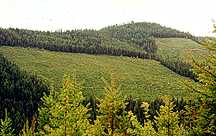






|
Logging Clearcutting Is clearcutting always
a bad technique? Moore (1995) offers some surprising comments about this practice.
The single biggest environmental reason for clearcutting has to do with the ability or
inability of different tree species to tolerate shade. Many species of trees simply will
not germinate and grow in the shade of other trees, even when the other trees are of the
same species. This is a common characteristic of pioneer tree species that are
particularly adapted to growing in areas that have been repeatedly clearcut. In British
Columbia about 60 percent of all forests are composed of species that are shade intolerant
to one degree or another. Tree species are not categorically either shade tolerant or
shade intolerant. Rather, they display a continuum of shade tolerance from very intolerant
to very tolerant with many species in between. Some species, such as Douglas-fir, are
shade intolerant in the wetter part of their range and yet are shade tolerant in drier
regions. (p. 87) Terra Bella Publishers Canada
Inc.
 In all this debate (on the use of clearcutting) one
thing has become clear, it is not clearcuts per se that are the problem but how, when, and
where they are created. It is easy, through sloppy procedures, to make clearcuts that
cause soil erosion, damage salmon streams, and reduce wildlife habitat. It is equally
possible, given adequate knowledge, to design clearcuts that protect soil, enhance salmon
streams, and increase wildlife habitat. These are not simple formulas that can be
communicated in 30-second news clips. An understanding of the place of clearcutting in
modern forestry requires a great deal of knowledge and judgment. Emotionally charged
presentations relying on photographs of messy landscapes are not adequate for deciding on
whether or not it is the correct method of tree harvesting and forest renewal. ( p. 91) Terra Bella Publishers Canada Inc. Photo: Courtesy of Dr. David L. Adams, Professor of Forest
Resources, University of Idaho, Moscow, Idaho. In all this debate (on the use of clearcutting) one
thing has become clear, it is not clearcuts per se that are the problem but how, when, and
where they are created. It is easy, through sloppy procedures, to make clearcuts that
cause soil erosion, damage salmon streams, and reduce wildlife habitat. It is equally
possible, given adequate knowledge, to design clearcuts that protect soil, enhance salmon
streams, and increase wildlife habitat. These are not simple formulas that can be
communicated in 30-second news clips. An understanding of the place of clearcutting in
modern forestry requires a great deal of knowledge and judgment. Emotionally charged
presentations relying on photographs of messy landscapes are not adequate for deciding on
whether or not it is the correct method of tree harvesting and forest renewal. ( p. 91) Terra Bella Publishers Canada Inc. Photo: Courtesy of Dr. David L. Adams, Professor of Forest
Resources, University of Idaho, Moscow, Idaho.
Ecosystem Management Debate
involving the preservation of one species or another is a frequent topic covered by the
media. The controversy surrounding the Northern Spotted Owl, for example, is legendary. A
recent important development in conservation strategy has been the broadening of the
notion of management to include an entire ecosystem--in addition to managing selected
species it supports. For example, in addition to individually managing certain trees,
fish, or birds in a forest, ecosystem-based management looks at what the authors below
call the "integrity" of the entire forest system. In the case of the temperate
rainforest, this concept proposes the management of the forest as an ecosystem.
This idea is extended to the management of rare or endangered species within the
context of the entire ecosystem:
Ecosystem management provides a context for ecosystem-focused as well as
species-focused conservation. Traditional approaches to conservation have focused on
species or populations of particular interest. Four key problems with the species-based
approach have emerged:
Species cannot be maintained in situ without their habitat or the ecosystems that
provide it.
Species-specific plans are too expensive, time-consuming, and labor-intensive to
implement for more than a very small fraction of the species known to inhabit temperate
rain forests.
The vast majority of species in temperate rain forests are little known, as are their
ecological relationships.
Because many species have conflicting needs, a management regime designed for one
species is likely to have negative impacts on others.
If our objective is to preserve biological diversity, adopting a conservation strategy
that places more emphasis on ecosystems and landscapes is the only feasible approach (Franklin, 1993c). (Lertzman, Spies, & Swanson, 1997, pp. 361-382).
"Granted with permission from The Rain Forests of Home, P.K. Schoonmaker, B. von
Hagen, and E.C. Wolf, © Ecotrust, 1997. Published by Island Press, Washington DC and
Covelo, CA. For more information, contact Island Press directly at 1-800-828-1302,
info@islandpress.org (E-mail), or www.islandpress.org (Website)."
[ Diversity ] [ Ecosystem Flexibility ] [ Natural & Human
Disturbance ]
[ Logging ] [ Tree Farming ] [ Precipitation & Water
Supply ] [ Researchers ]
[ Glossary
] [ Related Links
]
[ References
] [ PBL Model
]
[ Home
] [ Teacher
Pages ] [ Modules
& Activities ]
|


